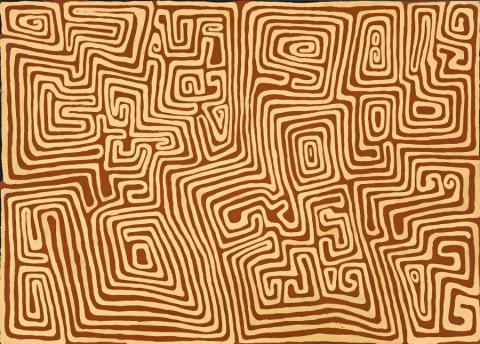TINGARI, 2007
JACKIE KURLTJUNYINTJA GILES TJAPALTJARRI
synthetic polymer paint on linen
153.0 x 213.5 cm
inscribed verso: size and Kayili Artists cat. 07-084
Kayili Artists, Patjarr, Gibson Desert
William Mora Galleries, Melbourne (stamped verso)
Private collection, United States of America
Kayili Artists, Recent Works, William Mora Galleries, Melbourne, 20 November - 14 December 2007
The influence of the late Jackie Kurltjunyintja Giles continues to resonate in the remote community of Patjarr in Western Central Australia, located south-west of Alice Springs. In 2008 Mr Giles’ wife, Ngumarnu Norma Giles, described her husband’s painting ability: ‘Mr Giles was the first one to start [painting]. We spread the blanket and we started painting and many watched. I watched and I learnt from him and started doing it myself.'1
Jackie Kurltjunyintja Giles was born at Tjamu Tjamu, a Kangaroo Dreaming site between Patjarr and Kiwirrkurra. ‘Jackie’s father was a maparntjarra, as traditional Aboriginal doctors are known to the Ngaanyatjarra, and he recognised the same gift in his son. Mr Giles was known across the Gibson Desert for his spiritual powers.’2 As a second generation maparntjarra, the artist’s cultural and ancestral knowledge is visible in the imagery he employs in his paintings. His paintings are a designed as a vehicle for sharing his cultural connections.
Marked by an arresting visual language, the work of Jackie Kurltjunyintja Giles is characterised by sinuous line work typically rendered in only two colours. As curator Georges Petitjean notes, ‘Giles’s work has a distinct monumental character. A heroic, male vision of the land and the stories connected to it resonate in strong graphic lines.’3 Forming a maze-like design, the warm hues of red and gold are a map of the Tingari cycle. The certificate from Kayili Artists states: ‘The tingarri people travel through the artist’s birth place of Tjamu Tjamu (west of Kiwikurra Community) to the walatu (claypan) site of Maruwa travelling north toward Wilikinkarra (Lake Mackay).’
1. Yiwarra Kuju: The Canning Stock Route, National Museum of Australia, Canberra, 2010, p. 173
2. Johnson, V., Lives of the Papuna Tule Artists, IAD Press, Alice Springs, 2008, p. 368
3. Petitjean, G., Contemporary Aboriginal Art: The AAMU and Dutch collections, Uitgeverij Snoeck, Utrecht, 2010, p. 77
